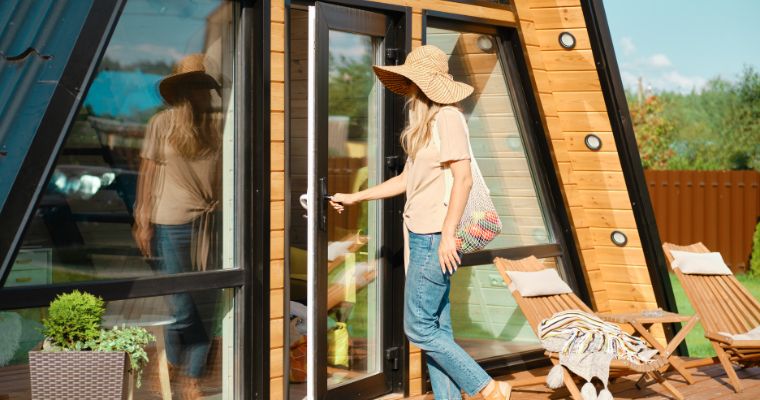Building a Home in Montana – 12 Steps to Create a Dream Home
Imagine waking up each day to mountain views, crisp air, and a home designed entirely around your values—beauty, comfort, and sustainability.
Building a custom home in Montana offers that rare opportunity, blending natural splendor with smart, eco-conscious design.
In places like Whitefish, you can incorporate features such as solar panels, natural HVAC systems, and cool roofs, along with using recycled materials.
These elements not only enhance comfort and functionality but also align with eco-friendly practices, ensuring your new home is both modern and environmentally considerate.
This article guides you through the essential steps to bring your dream home to life, from budgeting and land selection to sustainable building materials and finishing touches.
Ready to start building your dream home? Let’s explore the essential steps to make it a reality.
What Are the Key Steps for Building a Custom Home?
Building from scratch may look complicated, but the journey breaks down into 12 clear milestones.
Here are the 12 steps to building a home in Montana:
- Planning and Budgeting
- Considerations For Acquiring Land
- Finalizing the Designs
- Acquiring the Proper Permits
- How to Prepare the Land for Building
- Incorporating Sustainability
- House Framing and Exterior Construction
- Installing Interior Systems
- The Importance of Insulation
- Final Touches on the Interior
- Final Touches on the Exterior
- Home Inspection, Walkthrough, and Closing
This article is the complete guide for building a beautiful, custom home in Montana.
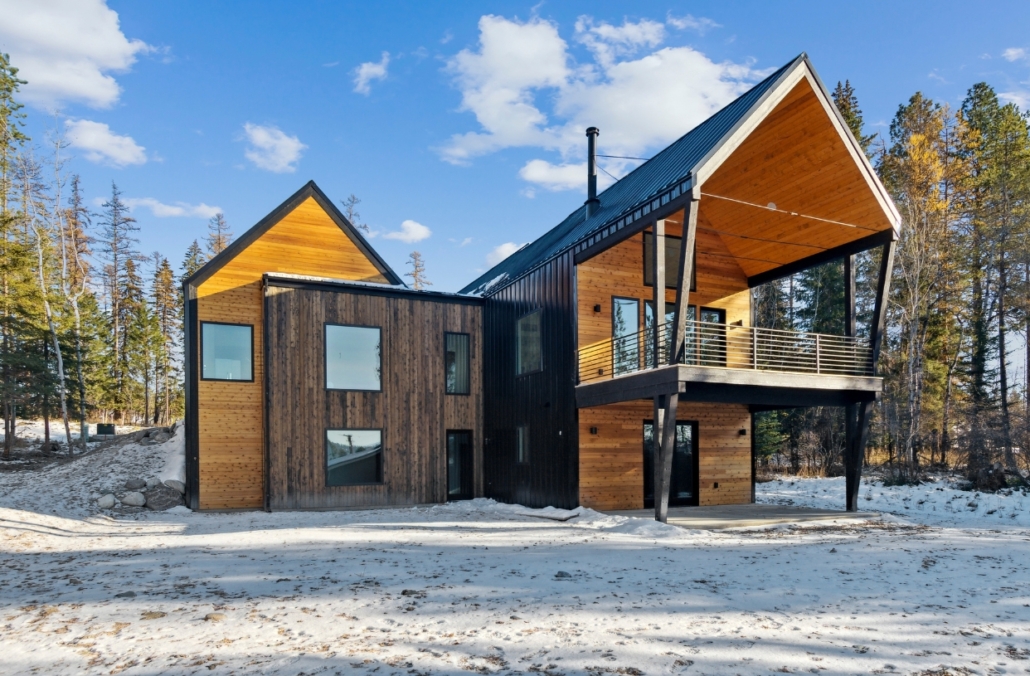
1. Start By Planning and Budgeting
Compared to buying a home, the process for financing a custom home is a lot trickier.
Prospective homeowners really need to have all their ducks in a row before they start dreaming of their future residence.
If you can’t afford to pay cash, you’ll need a construction loan. This type of loan is not a mortgage; it is a short-term loan that only covers the construction costs.
As your home is constructed, the lender will release the funds to pay for the necessary materials and labor. While the home is being built, the homeowner only has to pay interest on the loan.
When the construction is complete, the homeowner can either pay off the construction loan in full, refinance the construction loan into a traditional mortgage, or get an end loan to pay off the construction loan.
Tip: Homeowners should include a 20% contingency in their budget for labor delays and material price fluctuations.
2. Considerations For Acquiring Land
Finding the right lot for your new home is one of the most challenging parts of building a home in Montana.
Whether you’re a Montana native or a new resident, it can be helpful to utilize local knowledge.
A real estate agent with an Accredited Land Consultant designation will be able to help you find and purchase the ideal plot of land.
When you purchase a lot, there are a few things to keep in mind:
- Zoning Laws – It is only legal to build homes on land zoned as Residential. Other restrictions may apply if the area is considered historical or is designated for preservation. Additional local ordinances may place limits on the size, shape, design, and energy use of the home.
- Access to Utilities – It is both more affordable and more sustainable to choose a lot that already has utility hookups. This may mean buying land near an existing development rather than in the middle of nowhere.
- Ecology – Not all plots of land are suitable for building due to the shape of the land, presence of trees, type of soil, or conservation laws. Prospective homeowners are advised to have potential lots surveyed before purchase.
Tip: Visit the parcel in both spring runoff and winter freeze to assess drainage and access challenges that aren’t obvious in summer.
FEATURED LISTING
EXCLUSIVE WHITEFISH LISTING – 824 E 10TH STREET
Discover the exceptional features and prime location of this stunning home. With unique design and a rare investment opportunity, this is your chance to make it yours. Get full details today.
3. Finalizing the Designs
Once you have the land to build on, the next step is designing the home.
This is often an overlooked expense that sneaks up on future homeowners. To get your home underway, you’ll need to hire an architect to transform your list of preferences into a complete blueprint.
The architect can also discuss materials, practical considerations, and extra features with you.
Before the designs are finalized, you may want to consider adding a few customizations that will make your life easier:
- Extra large garage
- Hidden storage
- Mud room
- Built in doorway gates for pets and babies
- Dutch doors
- Oversized laundry room with space for additional appliances, drying racks, and a utility sink
- Heated floors in bathrooms
- Flexible sun room
- Greywater system to reuse water in toilets and irrigation
- Home orientation for passive solar heating
4. Acquiring the Proper Permits for Building a Home in Montana
The state of Montana requires building permits for single-family residences.
To obtain a permit, you’ll need to submit several documents, including:
- Architectural plans
- Erosion control plan
- Plumbing fixture count
- Public tree impact form
- Land use approval documentation.

5. How to Prepare the Land for Building
At this point, you are almost ready to start the building process.
Depending on the lot, the land may need to be cleared. The first stage of this process is grubbing, which means clearing the topsoil, removing vegetation, digging up roots, and moving large stones.
This process is usually required for all lots, unless you are building on a piece of land that once had a structure on it. Next, the land must be graded and reshaped to be suitable for a home.
Since Montana gets so much snow, local builders usually create a small slope on the land, so that snowmelt and rain will be channeled in the right direction.
6. Incorporating Sustainability into Your Home’s Foundation
The final bit of preparation is excavation for the foundation and installing utilities.
The foundation of your home is the most important aspect of the building process. It is also an area where sustainable home builders, like Eco Residency, like to embrace the use of green components.
There are currently 3 options on the market for eco-friendly foundations:
- Concrete Slab is durable enough to last decades. It also has a relatively low carbon footprint because it can be recycled into concrete aggregate and used for another home.
- ICF (Insulated Concrete Form) Foundation is a method of building foundations, cellars, and basements that dates back to the 1960s. Pre-built forms are dry stacked to form the shape of the foundation, then filled with concrete. Although more expensive than traditional concrete, ICF can contribute to better indoor climate control, insulation, sound proofing, and humidity regulation.
- Frost-Protected Shallow Foundations are commonly used in Scandinavian countries, but can be suitable for Montana homes. FPSF allows for a more shallow foundation on a home by providing strategic insulation. This option only works for lots that are relatively flat.
There are many sustainable ways to go about building a home in Montana.
However, some green technologies are only suitable for certain homes, depending on the surrounding land and the home’s design. For more information about sustainability in Montana, schedule a home builder consultation with Eco Residency.
Tip: Schedule framing during Montana’s late summer to avoid moisture delays.
FEATURED LISTING
EXCLUSIVE WHITEFISH LISTING – 824 E 10TH STREET
Discover the exceptional features and prime location of this stunning home. With unique design and a rare investment opportunity, this is your chance to make it yours. Get full details today.
7. House Framing and Exterior Construction
When framing gets underway, your new home will begin to take shape. Homes are typically framed with either wood or steel.
Wood is more affordable, so it is commonly used for single family homes. The most commonly used types of wood are douglas fir, treated pine, redwood, or cedar.
The latter two materials are more expensive than the former two, but they have excellent durability and moisture resistance. Steel framing is best for large, multi-family buildings, commercial spaces, and industrial warehouses.
Since lumber production takes a high toll on the environment, builders have started moving towards more sustainable options.
Bamboo is light, sturdy, easy to transport, grows quickly, and uses less water than trees, so it is emerging as a potential framing material. Recycled steel is another sustainable option for anyone building a home in Montana.
What Are the Best Materials for Siding and Roofing?
Once framing is complete, the builder can add exterior elements like siding and roofing.
This is another area of construction where homeowners can opt for sustainable building materials to reduce their carbon footprint.
Environmental options for home siding:
- Reclaimed wood is currently in style. It uses existing timber without having to cut down any new trees.
- Fiber cement is made of cement, sand, and wood particles. It can look like reclaimed wood, but has the added benefit of being extra durable.
- Bamboo siding is a green alternative to traditional wood. It looks chic and is resistant to both insects and moisture.
- Recycled metal siding is long-lasting, resistant to fire, and can be recycled over and over again to build new homes.
- Solar siding is now an option. The roof isn’t the only place where you can put solar panels.
When it comes to your new home’s roof, you can choose a traditional roof, a green roof, a cool roof, or a solar roof. Check out Eco Residency’s sustainable building guide for more information about the environmental impact of different roofs.
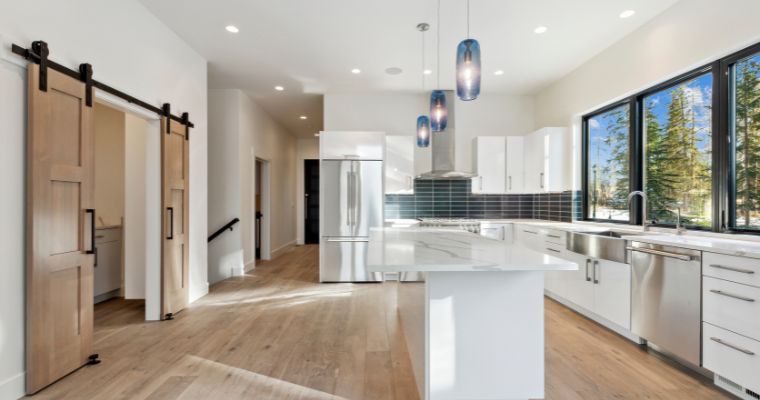
8. Installing Interior Systems in the Home
Plumbing, HVAC, and electrical are the most important systems for the functionality of your home.
If you are building a home in Montana, these systems can be augmented with green technologies that will both save you money on utilities and benefit the environment:
- Geothermal – The earth’s surface is naturally heated by the hot material in the earth’s core. In geothermal homes, a pump moves the earth’s heat into the home to warm the space.
- Active Solar – Solar panels on your roof or siding collect energy from the sun to offset your home’s energy consumption. Some homeowners can have their electrical bill reduced to zero by their solar panels.
- Greywater System – The left over water from showing, doing the dishes, and washing hands if often wasted. A greywater system reuses that water for flushing the toilet and watering the lawn.
- Tankless Water Heater – Compared to a traditional water heater, they use less energy, last longer, and are less likely to leak or break down.
9. The Importance of Insulation
The next step in the home construction process is insulating and drywalling the home. Insulation is important for climate control; it is what keeps the heat in the home during the winter and the heat out of the home during the summer.
Without proper insulation, all the eco-friendly technologies will go to waste. Homeowners have several options for sustainable insulation: wool, recycled denim and cotton, castor oil-based Icynene spray foam, and cork.
Tip: Highlight proper vapor barrier placement to prevent mold in Montana’s cold climate.
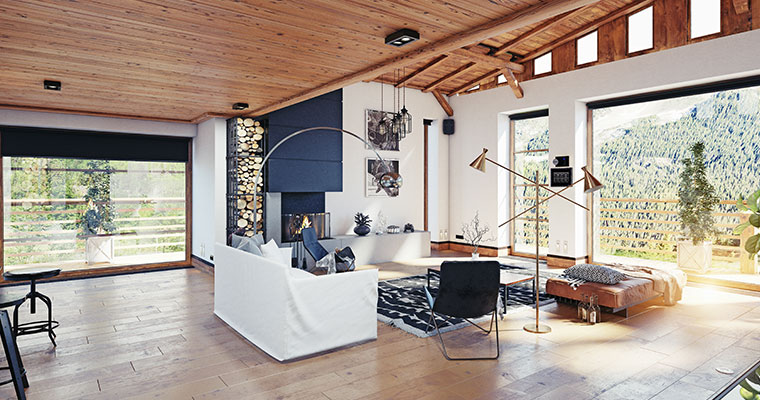
10. Final Touches on the Interior: Making a House into a Home
At this point, you get to see your custom home come to life.
This is also the time when you will have a lot of decisions to make, such as the paint colors, wall texture, trim colors, flooring materials, cabinet color, backsplash design, countertop material, and more.
You may want to embrace a minimalist style of home with neutral walls, understated lighting fixtures, and minimal decor.
Minimalism and sustainability have historically gone hand-in-hand. Some future homeowners embrace current design trends, such as bold colors, painted ceilings, wall texture, statement piece light fixtures, and maximalist trim.
Tip: Selecting all paint and hardware palettes at once often secures volume discounts from suppliers.
11. Final Touches on the Exterior: Designing a Sustainable Yard
Montana has such beautiful, natural plant life that most Montanans prefer biodiverse yards in place of mono-culture lawns.
Homeowners who opt for building a home in Montana generally prioritize water efficient, sustainable landscaping for their property.
The best grasses for lawns in Montana are sheep fescue, buffalograss, and blue grama. Compared to traditional lawns, these options are more drought resistant, use less water, and require less maintenance.
The most sustainable yards are planted with a mixture of fruits and vegetables, pollinator-friendly flowers and shrubs, native grasses, and trees of different sizes for shade.
12. Home Inspection, Walkthrough, and Closing
Before you can move into your new home, there are a few more administrative steps to go through.
Even in the case of custom built homes, you will still need to do a walkthrough and get an inspection.
The walkthrough is typically done with the builder or general contractor. You will make sure that everything is how you want it and keep an eye out for any dents, scratches, or smudges that will need to be patched up.
During an inspection, an independent inspector checks that the house is up to code. New constructions rarely have any problems, but this process is important for peace of mind.
Once your new home passes inspection, you will receive a Certificate of Occupancy, which will allow you to live in the home.
Once the home is complete, your construction loan will end.
This means that you will either have to pay off the loan amount, convert it into a traditional mortgage, or get an end loan.
FEATURED LISTING
EXCLUSIVE WHITEFISH LISTING – 824 E 10TH STREET
Discover the exceptional features and prime location of this stunning home. With unique design and a rare investment opportunity, this is your chance to make it yours. Get full details today.
Why Build a House in Montana?
Montana is an up-and-coming location that draws in temporary visitors and permanent residents from all over the U.S..
With so much available land, the state of Montana is the best place to build the custom home of your dreams.
While building a home from the ground up can seem overwhelming, local experts like Eco Residency are here to guide you through the process.
Tips for Building a House in Montana
Building in Montana comes with unique opportunities—and challenges. To ensure a smooth experience and a sustainable outcome, keep these practical tips in mind:
Plan Around the Seasons
Montana’s weather can be unpredictable, especially in the mountains. Plan the time carefully for major construction milestones like excavation to avoid weather delays and moisture-related damage.
Work With Local Experts
Engage builders, architects, and real estate agents who know the area. Their understanding of Montana building codes, climate conditions, and sustainable design will save you time, money, and headaches.
Choose the Right Land
Not all lots are created equal. Look for parcels with good drainage, utility access, and favorable sun exposure for passive solar heating. Always visit the land in multiple seasons to spot any hidden issues.
Budget for the Unexpected
Include at least a 15–20% contingency in your budget for unforeseen costs like material price changes, weather delays, or unexpected permitting requirements.
Prioritize Sustainable Materials
Montana’s natural beauty inspires many homeowners to build green. Opt for recycled or locally sourced materials, energy-efficient systems, and low-impact landscaping to minimize your environmental footprint.
Understand Zoning and Permitting
Each county may have different rules for building setbacks, septic systems, or environmental impact. Start early with research or consultation to avoid costly delays.
Case Studies
To better understand the timeline and process of building a custom home in Montana, let’s take a look at two Eco Residency projects in Whitefish that demonstrate how strategy, planning, and sustainability come together on the ground.
824 E 10th Street in Whitefish
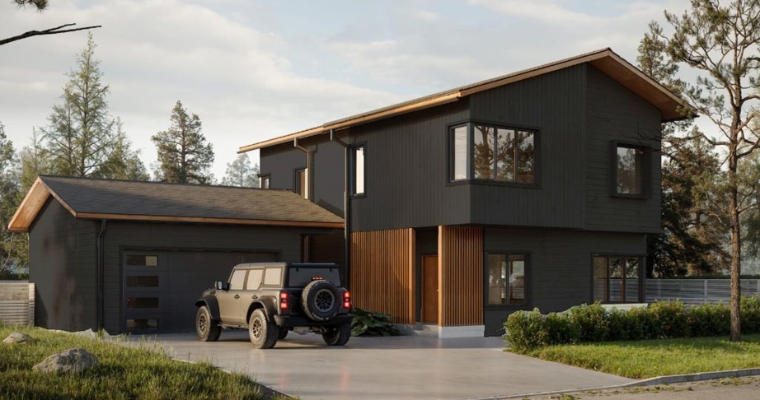
This custom home showcases the importance of thorough pre-construction planning. Despite a surprise cold snap and minor permitting delays, the project remained on track thanks to the team’s proactive approach. Close coordination with subcontractors and meticulous attention to detail kept the timeline moving forward.
The result? A stylish, energy-efficient home delivered without compromising quality.
158 Mountain Brook Lane, Whitefish, MT
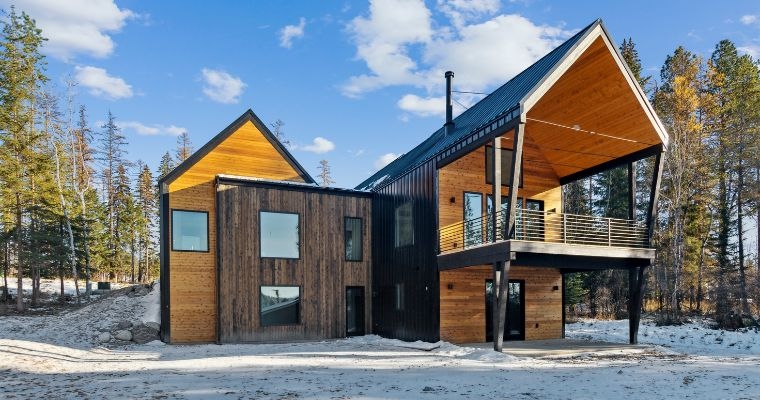
A standout in modern mountain architecture, this project is a model of precision and luxury. By ordering long-lead materials like cabinets and windows early in the process, the team avoided unnecessary delays. Leveraging detailed scheduling tools and a streamlined build strategy, the home was completed within its projected timeframe—proving that high-end design and efficient execution can go hand-in-hand.
FAQs & Main Considerations Before Deciding to Build a House in Montana
The average price to build a house in Montana is around $300,000. This amount can go beyond $600,000 if you include land costs, excavations, permits, and other expenses. The Montana housing market isn’t that competitive. The median home sales price in January 2025 has decreased in the past 3 months to $540,700. For Whitefish specifically, we have a dedicated guide Cost to Build a House in Whitefish.
On average, building a custom home in Montana takes 9 to 12 months. This timeline includes design, permitting, construction, and inspections. Factors like weather, supply chains, and customization levels can impact the duration.
First-time homebuyers in Montana should start by getting pre-approved for financing, researching local market trends, and partnering with experienced real estate agents. Understanding zoning laws, water rights, and environmental considerations is crucial before purchasing land or a built home.
If you’re planning on living in Whitefish, Montana, check out our guide to Cost of Living in Whitefish.
Generally, buying an existing house is cheaper upfront. However, building allows for custom features, energy efficiency, and long-term savings on maintenance and utilities.
Yes, Montana requires building permits for residential construction. The process involves submitting architectural plans, environmental impact forms, and other documentation depending on the county. First-time homebuyers in Montana should start by getting pre-approved for financing, researching local market trends, and partnering with experienced real estate agents. Understanding zoning laws, water rights, and environmental considerations is crucial before purchasing land or a built home.
A $500,000 budget can build a quality custom home in Montana, especially with smart planning. Costs vary by size, location, and chosen materials.
FEATURED LISTING
EXCLUSIVE WHITEFISH LISTING – 824 E 10TH STREET
Discover the exceptional features and prime location of this stunning home. With unique design and a rare investment opportunity, this is your chance to make it yours. Get full details today.
Get Starting Building Your New Home Today!
Montana is the perfect location to put down roots!
With an abundance of natural beauty, a vibrant cultural scene, and plenty of year-round outdoor activities, you’ll quickly discover why so many people are making Montana their new home.
Ready to get started on your sustainable Montana home? Reach out today for and let’s bring your vision to life.
Let us guide you through every step of the process to create a sustainable and beautiful living space tailored to your needs!
